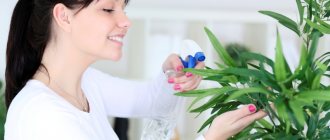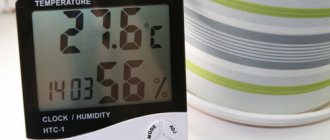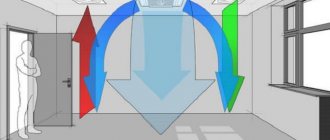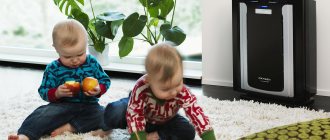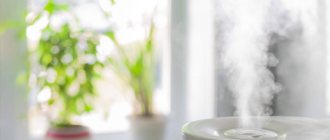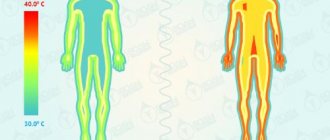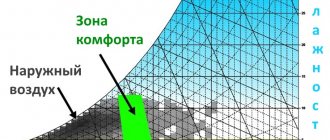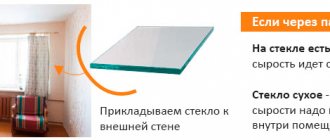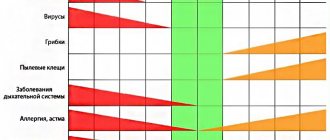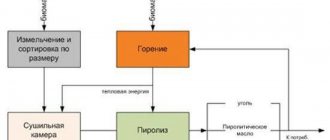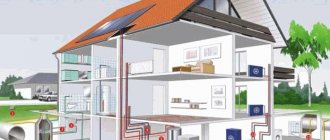A hygrometer is an instrument used to measure the humidity in the atmosphere, indoors, or other enclosed space. How to use a hygrometer? It usually does not measure humidity itself, but determines indirect changes in the properties of a substance when absorbing moisture, on the basis of which the humidity indicator is determined through calculations.
Modern electronic devices use condensation temperature (dew point). A common use of a hygrometer is to monitor weather conditions and obtain information for weather forecasting. Combined with temperature, barometric pressure and wind speed data, humidity tells a lot about the weather ahead. For example, low barometric pressure associated with low temperature and high humidity levels indicates that rain is about to fall. A person needs such data so that he can comfortably organize his affairs.
History of the creation of a moisture meter
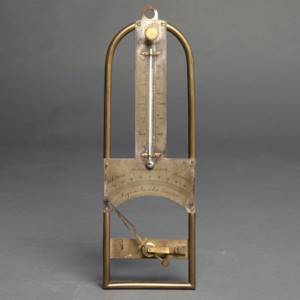
Humidity is more difficult to measure than temperature, which is why the first hygrometers were not entirely accurate. Leonardo da Vinci invented the first version of the hygrometer already at the end of 1400. Guillaume Amontons invented the hygrometer, which was similar to a three-fluid barometer, in 1687. In 1781, Horace Benedict de Saussure (1740–1799) discovered that human hair was a good indicator of moisture. A major breakthrough in hygrometry was made in 1802 by British explorer John Dalton (1766-1844). He showed that the amount of water vapor required for saturation depends strongly on temperature. This led to an understanding of relative humidity and how to use a psychrometric hygrometer.
The moisture meter readings are interchangeable; simple calculations convert them from one type to another - relative humidity helps determine the dew point or absolute humidity.
Device selection
Before purchasing a particular hygrometer, you need to find out information about it. There are measuring instruments for determining air humidity. There are also varieties. Let's consider measuring instruments (hygrometers):
- wall mounted appliance;
- benchtop moisture meter;
- mechanical device;
- digital device.
Which devices to choose? The choice of one type of device or another depends on the consumer himself. First, you need to familiarize yourself with the technical characteristics of the device and some nuances. Let's take a closer look at them:
- Decide how important measurement accuracy is to you. Because different devices give different values. Some hygrometers will give exact values, while others will give approximate values. But this does not mean that these are “bad” devices. Most buyers are content to purchase hygrometers that provide “inaccurate” readings.
- Next, you need to immediately decide on the future location of the device, since not all types and types of devices used can be installed anywhere in your home. For example, not all devices can be located on walls. Although it is recommended to purchase wall hygrometers, using them for monitoring.
- We check that the measuring device has the required configuration. Indicators and a psychrometric table must be available. If this is the case, then you are purchasing a high quality moisture level meter. It will measure the relative humidity of the air accurately.
These are the main three points to which you need to pay attention. Before purchasing, it is best to find out the information from the product seller, who will help you choose the right device, subject to all requests and conditions.
Moisture meter and its features
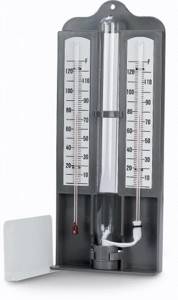
In order to learn how to use a hygrometer, you need to consider the main types of devices for measuring humidity. The psychrometer consists of two separate thermometers mounted on one body. One is dry and the other is wet (wet). The lower end of the wet thermometer is covered with a special cloth that acts as a wick. It is constantly in the water, cooling and wetting the wet bulb. At temperatures (T) above the freezing point of water, the wick reduces the wet-bulb temperature, which is usually lower than the dry-bulb temperature. However, when the temperature of the air drops below zero, the wet bulb becomes covered with a thin layer of ice, and it can be warmer than the dry bulb.
Relative humidity is calculated based on the ambient temperature, dry bulb temperature, and the temperature difference between the dry and wet bulb temperatures. Relative humidity is determined using a psychrometric chart. When two temperatures are equal, the air is completely saturated, and the greater their difference, the drier the air. Using special tables, knowing the T air and the psychrometric difference (T – T m), the remaining air parameters are determined. Psychrometers are commonly used in meteorology and in the heating, ventilation and air conditioning systems of residential and public buildings.
Types of hygrometers
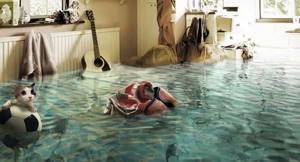
If we try to very briefly answer the question of how to use a hygrometer, we can say that it all depends on the type of measuring equipment. All devices that control the level of humidity in rooms have different designs and operating principles. They also differ in additional characteristics.
All hygrometers are divided into two large groups - mechanical and electronic devices. The first ones are as simple as possible, since they have a dial that shows real indicators of moisture contained in the air. The second, more complex designs are equipped with a display that displays the necessary information. If we talk about the operating principle of hygrometers, there are quite a few types of designs.
Weight hygrometers
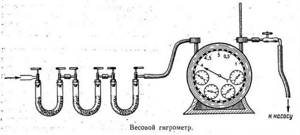
This equipment is designed to calculate absolute values. For measurements, these instruments contain tubes filled with hygroscopic material - filler. Once air passes through it, the weight of the material changes because it absorbs moisture. A special pump is used to collect the sample. The system is weighed before and after air injection. To obtain absolute humidity, calculations are carried out using the results obtained and another value - the volume of air passed through.
Psychrometric hygroscopes
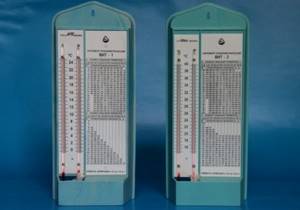
This device is one of the options for which owners need to carry out a series of actions to find out the required value. These devices have two thermometers at once. One of them is dry, the second thermometer, on the contrary, is constantly moistened. To ensure this condition, the equipment is equipped with a feeder - a glass flask, which must be constantly filled with water. The calculation is carried out by the owner himself. Determine relative humidity using the table that comes with the hygroscope.
Hair or hair appliances
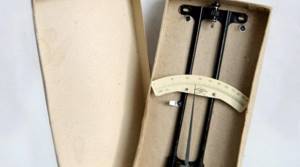
These are the simplest designs, which, however, guarantee the accuracy of the results. A hair hygrometer uses either human or synthetic hair, stretched with a weight onto a frame equipped with an arrow. This main working element is pre-degreased. When the humidity in the room changes, the length of the hair also changes. This change is immediately recorded by an arrow deviating in one direction or another.
Capacitive devices
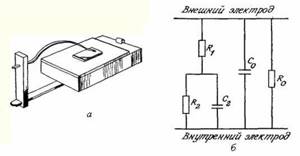
These devices use oxide capacitors, the capacitance of which changes simultaneously with changes in the concentration of moisture in the air. The main disadvantage of such devices is the need for their periodic calibration. The reason for the operation is a decrease in capacity over time. This phenomenon makes the device less accurate.
Film hygrometers

The operating principle of these moisture meters is similar to that used in hair devices. Only in this case, the sensitive element is a special film, also connected to the dial arrow. Any changes in air humidity lead to changes in the size of the film. The arrow similarly moves to the right or left.
Ceramic equipment

These devices are arrow dials. The role of the sensitive element in them is played by a special type of ceramic - clay with silicon. The electrolytic resistance of the mixture is affected by the level of humidity. Their distinctive feature is high accuracy.
Electrolytic devices
In these designs, the main element is an insulating plate made of polystyrene or glass. Its coating is a layer of electrolyte. The operation of the device is based on measuring its resistance, which changes depending on the concentration of moisture in the air.

There are two more types of moisture meters. These are condensation, or Lambrecht hygrometers, and resistive devices. The first devices use a small mirror. Its temperature changes under the influence of the external environment. The operating principle of resistive hygroscopes is based on measuring the electrical resistance of polymers and salts.
Which option should you prefer?
In this case, the answer depends on the function of the room in which the device will be located. For medical institutions, schools, warehouses and production facilities, the optimal option would be a simple, but accurate and reliable option - a psychrometric hygrometer.

If you are buying a device for a home or apartment, then there is more choice: you can buy both an electronic and a mechanical moisture meter. Since small errors do not play a significant, important role for home use, the choice in this case depends only on the preferences of the owners, on convenience, the interior of the room, etc.
However, it is not recommended to buy psychrometric devices containing toluene for domestic use if there are small children and animals at home. The reason is a potential “accident”: thermometers can fall and break, and the consequences of contact of the “most curious” creatures with an unsafe liquid cannot be predicted.
Electronic mirror dew point hydrometer

The dew point is the temperature at which a sample of moist air (or any other water vapor) at constant pressure reaches water vapor saturation. At this saturation temperature, further cooling causes water to condense. How to use an electronic hygrometer? Electronic mirror dew point hydrometers are among the most accurate instruments available today. They use a cooled mirror and an optoelectronic mechanism to detect microcondensation on the mirror surface.
The mirror temperature is controlled by electronic feedback to maintain dynamic equilibrium between evaporation and condensation, thereby carefully measuring the dew point temperature. These devices require frequent cleaning, a trained operator, and periodic calibration to achieve a high level of accuracy. More recently, spectroscopic cooled mirrors have been introduced. In them, the dew point is determined using spectroscopic analysis, specifying the nature of condensation. Their main advantage is that they operate at temperatures down to –70°C.
Why do you need to regularly measure indoor moisture?
Many people wonder why it is necessary to measure humidity in rooms, because it does not affect anything. But it turns out that this opinion is wrong, and this must be done. If the air humidity does not correspond to normal values, then a weakening of the immune system may occur and fatigue may appear. Too dry air can lead to dry skin and dehydration. The mucous membranes suffer the most, because they are in direct contact with the air. They can become covered with microcracks, dry out, and open the way for viruses and microbes to enter our body.
Important! If the moisture concentration is high, then the thermoregulation mechanism does not work. You have to use sweating to cool down.
The body begins to work more intensely, which leads to overheating. If you constantly stay in rooms with high humidity, the body is less resistant to infections, which can also lead to kidney disease, tuberculosis and much more. Excess humidity causes fungi and mold to form on the walls of the house, which contaminate the air with harmful spores. Therefore, it is very important to maintain normal humidity in the house.
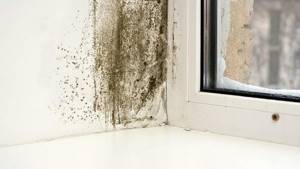
Effects of high humidity
Indoor hygrometer: types and functions of the device
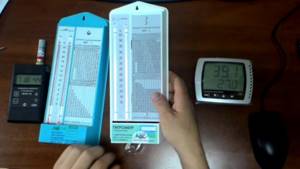
The psychrometric method is used to change air humidity in residential, public and industrial buildings. How to use a psychrometric hygrometer? The device consists of two thermometers. The end of one of the thermometers, in the psychrometric body on the right, is wrapped with the end of a small cloth - a wick (medical bandage) in several layers, and the second is lowered into a container with clean water. The glass is closed with a special lid, which has a hole for the wick. The wet bulb temperature begins to drop as heat is absorbed; the equilibrium point between evaporation and the decrease in wet bulb temperature occurs after approximately 30 minutes.
A dry bulb measures the temperature of the indoor air in a room, while a wet bulb measures the temperature of the indoor air. How to use a psychometric hygrometer is described in detail in the instructions that come with the device. The panel contains psychrometric tables for determining air humidity. Removal is carried out by an employee without delay, since a long stay near the device can change the readings and distort the result of measuring humidity. For the most accurate result, the device must be installed so that the operator’s eyes are located at the level of the meniscus of the thermometers.
The most common indoor psychrometers are the thermometer-hygrometer VIT-1 and VIT-2. Structurally, they are very similar, but have significant differences in the field of application, so VIT-1 is used when the air temperature in the room is from 0°C to +25°C, and VIT-2 is used when the air temperature in the room is from 0°C to +25°C, and VIT-2 is from +15°C to +40°C.
An example of determining air humidity with a psychrometer:
- Dry bulb temperature: +23.0°C;
- wet: +20.5°C;
- temperature difference: +2.5°C;
- Using the psychrometric table on the panel, we determine the relative humidity: 77%.
This indicator of relative humidity is unacceptable, since GOST 30494-96 “Indoor microclimate parameters” establishes the following humidity standards:
How to find out air humidity without measuring instruments
To carry out this experiment, you will need a regular glass, some water and a refrigerator. Place a glass of cold water in the refrigerator for several hours. When the temperature of the liquid in the vessel reaches 3–5˚С, the glass is placed in the room where air humidity will be measured.
The glass should be located as far as possible from radiators or other heating devices for greater accuracy of the result.
If the air in the room is very dry, then condensation will be observed on the surface of the glass, which will disappear after 5 - 10 minutes of observation. If the air in the room is very humid, then large drops of condensation form on the walls of the glass within 5–10 minutes. If none of the two previous options are observed, the air in the room is of medium humidity.

Hygrometer VIT-2
The design of VIT-2 is practically no different from VIT-1. The plastic case contains thermometers, a feeder and a table for calculations. How to use the VIT 2 hygrometer? The principle of operation is no different from VIT-1, but their psychrometric tables are different, therefore the calculations for humidity also differ.
First, the dry T is determined, then the wet T, and the required indicator is determined from the delta T at the intersection point of the “dry” thermometer using the psychrometric table. The air speed should be no more than 2 m/s so as not to distort the measurements.
Hygrometer KTJ-TA218A
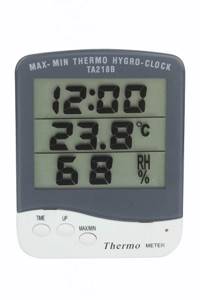
The KTJ-TA218A moisture meter is suitable for measuring indoor humidity and temperature levels. How to use the TA218a hygrometer? A thermohygrometer or digital thermohygrometer is an electronic instrument that measures and displays temperature (T) and relative humidity (RH). Applications: ventilation and air conditioning, climate control, hospitals, food processing plants, saunas, gyms, offices, conference rooms, museums, libraries, archives, computer rooms, printing, warehouse or home automation.
- External temperature measurement range: 0°C – 50°C.
- Display indication: C/F.
- Humidity measurement range: 10-95% RH.
- Temperature measurement accuracy: +/- 1°C.
- Humidity measurement accuracy: +/- 5%.
- length of cable:
2 m.
- Supply voltage: 1.5V DC AAA.
- Display: 3.8 inches.
What is special about the Assmann psychrometer?
The Assmann psychrometer is a much more complex and more reliable device for measuring air humidity. Both thermometers of the design are located at the lower ends in a special metal case, which protects them from sunlight, thermal influences, and also from various damages. The air moves at a constant speed due to the operation of the fan. This fan, also known as an aspirator, blows the thermometers at a speed of 2 m/sec.
Determination of humidity using this psychrometer: the device is suspended at the test site at a height of 1.5 m from the floor; results are obtained after 10 - 15 minutes in winter and after 4 - 5 minutes in summer.
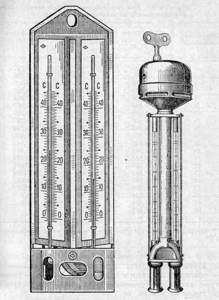
What the August psychrometer and Assmann psychrometer have in common is that both have glass-mercury thermometers in their design. The disadvantage of these devices is their fragility and, accordingly, the inability to carry out measurements remotely.
Moisture meter MODEL C-02
The device measures CO2, T and humidity, with a triple LCD display. How to use a hygrometer? MODEL C-02 T wet bulb thermometer and dew point function. Dual band infrared CO2 sensor.
GAOTek Mini Temperature and Humidity Hydrometer
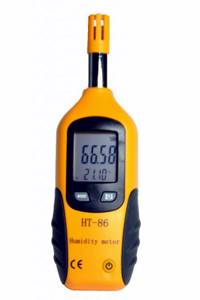
The GAOTek Mini Hygrometer is designed with an integrated measurement function over a wet bulb temperature range of 0°C to 80°C. How to use a hygrometer correctly? The integrated measurement function is ambient temperature, humidity, dew point and wet bulb temperature. This is a digital T meter with high accuracy and low power consumption. It is equipped with humidity sensors and an industrial-grade digital display. It is suitable for measuring T and humidity in any industrial sector, in workshops, factory warehouses, libraries, offices, laboratories, etc.
- high productivity and accuracy;
- fast reaction time;
- control of dry and wet thermometers;
- microprocessor design;
- sleep mode;
- screen hold;
- backlight function;
- low power consumption;
- digital screen;
- dew point temperature;
- temperature range from -30°C to +100°C;
- Humidity range 0% to 100% rh;
- dew point temperature from -30°C to +100°C;
- wet bulb temperature 0°C to 80°C;
- humidity accuracy 2% rh (from 20% to 80% at + 25°C);
- response time 10 seconds (90% T+25°C).
Hydrometer Testo 645
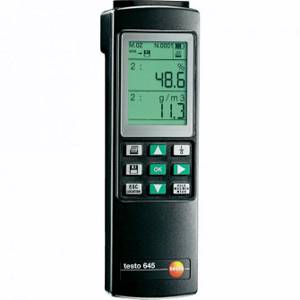
Dual-channel measurement of T and humidity. Very accurate humidity measurement up to ± 1% rF with internal measurement memory. How to use a hygrometer? Testo 645 displays the following values at the touch of a button: humidity, dew point, enthalpy and temperature. Convenient evaluation of measurement data with transfer to a PC and indicating the measurement location. Maximum humidity 100%. Minimum humidity 0%. Temperature from -50°C to +150°C.
Instructions (manual) for the operation of psychrometric hygrometers VIT-1 and VIT-2
Introduction 1. The instructions define safety measures when working with a hygrometer, preparing it for work and operating procedures, typical malfunctions and maintenance of the hygrometer. 2. Technical characteristics of the hygrometer, amendments to hygrometer thermometers, and manufacturer’s warranties are given in the passport.
Indication of safety measures when working with a hygrometer
1. When working with a hygrometer, it is prohibited:
Subject the hygrometer to sharp shocks both during installation and during operation;
Wipe the thermometer scale and psychrometric table with solvents, acids and other similar liquids;
Overheat the thermometers of the VIT-1 hygrometer more than 45°C and the VIT-2 hygrometer more than 60°C. If overheated, the thermometer tanks will be destroyed.
2. When thermometers are destroyed, the thermometric liquid toluene is removed from surrounding objects with hot water. Toluene is toxic, flammable, flash point is about 5°C.
Design and principle of operation of a hygrometer
1. A hygrometer is a device assembled on a base made of phenolic plastic or other materials with similar properties. Two thermometers with a scale, a psychrometric table, and a glass or plastic feeder filled with distilled water are attached to the base. The thermometer reservoir under the inscription “Humidification.” moistened with water from the feeder using a cambric or chiffon wick. 2. The method of measuring relative humidity with a psychrometric hygrometer is based on the relationship between air humidity and the psychrometric difference - the difference in the readings of the “dry” and “wet” thermometers, which are in thermodynamic equilibrium with the environment. By taking the thermometer readings and introducing corrections to their readings, the difference in thermometer readings is determined. Then, based on the readings of the “dry” thermometer and the difference in the readings of the “dry” and “wet” thermometers, the relative air humidity is determined using a psychrometric table.
Preparing the hygrometer for use
1. Unpack the hygrometer and make sure that the device is complete in accordance with the passport. 2. Remove the feeder from the base. Fill the feeder with distilled water. Filling is done by immersing the feeder in a vessel with water, sealed end down. 3. Place the feeder on the base so that there is a distance of at least 20 mm from the edge of the open end of the feeder to the thermometer reservoir, and the wick does not touch the walls of the open end of the feeder. Attention! Before installing the feeder into the operating position, moisten the wick by dipping the wet bulb reservoir into the feeder with water. 4. Place the hygrometer in a vertical position at eye level of the person working with it. The location where the hygrometer is installed must be free of vibrations and sources of heat or cold that would create a temperature difference between the lower, main reservoir and the upper reserve reservoir of more than 2°C. 5. The psychrometric table installed on the base of the hygrometer is valid for a certain speed of vertical air flows (aspiration speed) washing the hygrometer. The aspiration rate is indicated in the table. You can see the full psychrometric table for the VIT-2 hygrometer at the link. 6. Before measuring relative humidity, measure the aspiration rate directly under the hygrometer. Measure the aspiration rate using a vane anemometer U5 GOST 6376-74. It is possible to use the previously produced anemometer ASO-3, type B, GOST 6376-52. The measurement procedure is in accordance with the anemometer data sheet. The aspiration rate measured by an anemometer is rounded to tenths of m/s according to the arithmetic rounding rule. You can buy a VIT hygrometer aspiration device by clicking on the link. 7. Measure relative humidity with a hygrometer only after establishing the readings of the hygrometer thermometers. The minimum exposure time of the hygrometer in the measured environment is 30 minutes.
Operating procedure of a psychrometric hygrometer
1. Take readings from the “dry” and “wet” thermometers. When taking readings, the worker’s eye should be at the level of the horizontal tangent to the meniscus of the liquid so that the scale mark at the reference point is visible as a straight line. 2. The person working with the hygrometer must be at a distance from it where the scale marks are normally visible and be careful not to breathe on the thermometers during readings. When reading thermometers, tenths of a degree are first quickly counted, then whole degrees. 3. Determine the temperature using thermometers with an accuracy of 0.1 ° C, introducing corrections to the thermometers given in the hygrometer data sheet to the readings. Calculate the temperature difference between the “dry” and “wet” thermometers. Corrections are introduced by algebraic addition. 4. If there are no corrections in the passport for the readings made on the “dry” and “wet” thermometers, calculate the corrections by linear interpolation using two corrections related to the temperatures between which the thermometer reading lies. 5. Determine the relative humidity using the psychrometric table. The desired relative humidity will be at the intersection of the temperature lines according to the “dry” thermometer and the temperature difference between the “dry” and “wet” thermometers. 6. If the table does not contain the resulting temperature difference between the “dry” and “wet” thermometers, use interpolation to determine humidity. If there is no dry-bulb temperature in the table, to determine humidity, use interpolation only for those areas of the psychrometric table in which a 1°C change in dry-bulb temperature results in a change in relative humidity of more than 1%. For the remaining areas of the table, round the dry-bulb temperature values to the nearest table value using the arithmetic rounding rule.
An example of determining relative humidity by interpolation
1. Determine the temperatures using the “dry” and “wet” thermometers and the difference between these temperatures.
Thermometers
| Measured temperatures | Amendments to thermometers according to the passport | Temperatures after corrections | |
| "Dry" | Тс=22.5°С | -0.15°С | 22.35°C |
| “Moisturized” | TV=16.1°С | +0.20°С | 16.3°C |
We accept Tc = 22.4°C, the temperature difference (Tc-Tv) is equal to: 22.4-16.3 = 6.1°C.
2. Determine the relative humidity for Тс=22.4°С and Тс-Тв=6.0°С, for this purpose by interpolating the relative humidity value according to the table for Тс from 22 to 23°С and Тс-Тв=6.0°С .
| Ts according to the table | Ts-TV difference according to the table | Relative humidity |
| 22 °C | 6.0 °C | 48 % |
| 23 °C | 6.0 °C | 50% |
With an increase in Tg by 1°C, the relative humidity increases by 2%, therefore, an increase in Tg by 0.4°C will increase the relative humidity by (0.4x2)/1=0.8%. For Тс=22.4°С and Тс-Тв=6.0°С, relative humidity is equal to: 48+0.8=48.8%. We accept “Fp” = 4.9%. 3. We determine the relative humidity for Тс-22.4°С and Тс-Тв=6.5°С, for which we interpolate the relative humidity values according to the table for Тс from 22 to 23 and Тс-Тв=6.5°С.
Hygrometer maintenance
In order for the device to work properly, the filter must be changed regularly. It is also necessary to ensure that there is always distilled water in the feeder. It should be added in advance, at least half an hour before the start of measurements. Sometimes you can use boiled water instead of distilled water. You need to boil it for 15 minutes or longer, and then cool to room temperature, after which the liquid can be added to the feeder.
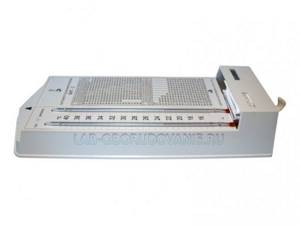
Psychrometric hygrometer VIT-2
To ensure that the wick tied around the tip of the “Moistened” thermometer is always clean, it needs to be changed once every 2 weeks. This is with normal dust content in the air (no more than 5 mg of dust per cubic meter). If there is increased dust in the place where measurements are taken, then the wick needs to be changed more often. After removing the contaminated wick, wipe the thermometer reservoir with a cotton swab moistened with warm water.
The length of the new wick should be at least 6 cm. The moistened wick is placed on the tip of the thermometer and tied to it with a cotton thread. The second tip of the wick (from 7 mm long) is lowered into the feeder with water.
Also, servicing the hygrometer involves periodic checks 1-2 times a year, guided by the MI-737-83 manual. The results of the checks must be recorded in the device passport.
